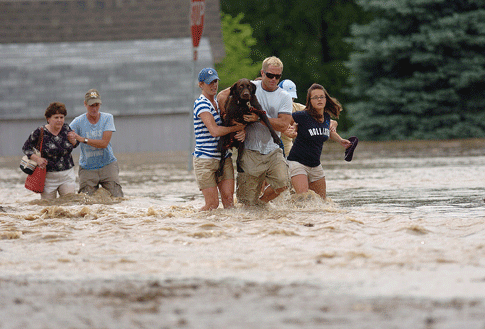The Other Big Meltdown
Is global warming shifting into high gear? A federal project aims to find out

To predict the unpredictable: That’s the goal of a new government initiative on abrupt climate change. As the atmosphere reels under the influence of greenhouse gases, scientists fear the growing risk of dramatic environmental changes occurring within decades—far faster than current computer models predict. Ice sheets might not just melt but collapse wholesale, rapidly raising sea levels and flooding entire coastlines. Regional rain shortages could cause megadroughts that choke our water and food supply. William Collins, head of the climate-science department at Lawrence Berkeley National Laboratory, calls the possibility of abrupt climate change “a huge threat to the security and stability of our nation and the world.”

On the Brink
Earth is no stranger to the disruptive forces of sudden climate change. Tree-ring data show that sudden drying in the American West from 900 to 1400 induced one of the most tenacious megadroughts on record, turning river basins into sheets of sand and contributing to the collapse of the agrarian Pueblo “cliff-dweller” civilization. Scientists suspect that increased greenhouse gases may be forcing another shift, but no computer model is yet capable of forecasting if, when, and how fast that shift might be happening. So with a $2-million-a-year investment by the U.S. Department of Energy, six national laboratories and a host of universities are joining forces in a prediction project called IMPACTS (Investigation of the Magnitudes and Probabilities of Abrupt Climate Transitions). Led by Collins, IMPACTS will pinpoint the mechanisms that drive abrupt climate change and add them to the Community Climate System Model (CCSM), one of the country’s two leading computer climate models. Accurate predictions won’t eliminate changes, but they might give us time to prepare.

30’s Drought
Megadrought is a high priority for IMPACTS. Current models show that global warming will already make the American Southwest steadily drier, but changes in plant life could speed up and intensify the process. During prolonged drought, plant roots deprived of water cease to grow longer and tap deep groundwater. “The vegetation may actually die off,” says Ruby Leung, an IMPACTS modeler at the Pacific Northwest National Laboratory. Without plants to transport groundwater to the top layer of soil, drought conditions could compound, setting the stage for a megadrought.
Another tipping point may be ice sheets, particularly in the West Antarctic. They’re disintegrating briskly, but current computer models don’t take this into account, in part because the mechanism by which the sheets crumble is still unclear. History shows that sea levels are capable of rising 20 times as fast as the current rate of one tenth of an inch per year, says New York University oceanographer David Holland, who is parsing recent field data on the mechanisms into ice-sheet equations for the CCSM. “At that rate,” he says, “you would have a problem in 100 years.” Given that one in 10 people worldwide live in low-elevation areas, these are important numbers to know.
Until recent years, the national research focus has been to characterize trends in gradual warming and its long-term effects. “It’s like learning to drive,” says Richard Alley, a glaciologist at Penn State University and a leader in bringing attention to abrupt climate change. “We generally start by trying to control the car. Then we learn about evasive maneuvers to avoid drunk drivers crossing the centerline.” IMPACTS signals that priorities are shifting. The hope is that they’re shifting faster than the climate is.